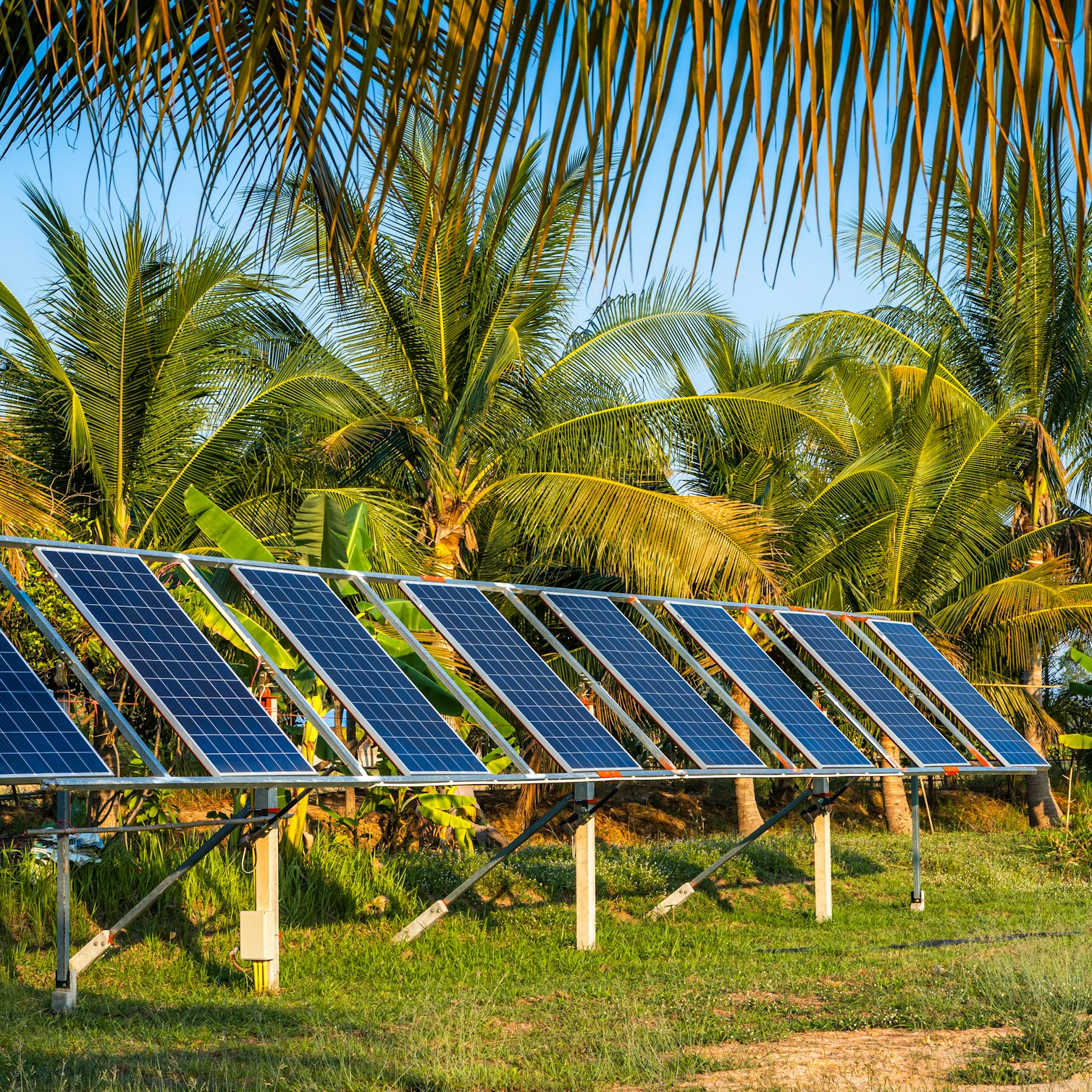- Solar energy blog
- The rise of photovoltaics in the Caribbean
The rise of photovoltaics in the Caribbean


Diego López
Senior Account Director LatAm
Diego López is RatedPower's Sr Account Director LatAm.

Content
It’s no secret that we are barrelling towards a climate crisis. Countries worldwide are making efforts to reduce greenhouse gas emissions to mitigate the damage humans have done to the environment and stop us from passing a point of no return.
This global movement entails adopting cleaner alternatives like solar, wind, hydro, and geothermal power and advancements in energy storage and grid technologies. By promoting eco-friendly energy solutions, the green energy transition seeks to curb greenhouse gas emissions, improve air quality, and foster a more resilient and sustainable future for future generations.
After a slow start, the Caribbean is now taking steps toward becoming a part of the green energy transition. With high irradiance and year-round sunshine, the region is perfectly positioned to take advantage of solar photovoltaic (PV) technology to supply a significant proportion of its energy mix.
In this blog, we’ll look at the current state of the Caribbean’s energy market and how it is starting to embrace solar power. Read on to find out more!
Are you attending Energyear Caribe 2023? We are sponsors and will be there in person, so we'll be delighted to meet you to have a chat. Book a meeting with us to make sure you have our undivided attention.
The Caribbean energy market
Currently, most of the Caribbean region relies heavily on diesel fuel and natural gas imports to meet its energy needs, excluding Trinidad and Tobago and Guyana, which have their own reserves. Imported petroleum products account for 80% of the region’s energy needs and not only have a high environmental impact but cost around $7 billion annually.
The Caribbean faces a complex set of challenges when it comes to providing energy for its population. The decentralized nature of the region, with many small islands spread across large distances, means it is difficult to implement the infrastructure required to supply power to those who need it.
This, coupled with the small size of individual Caribbean markets, make it challenging to achieve economies of scale, hindering investment in large infrastructure projects and renewable energy systems.
Are you interested in exploring the challenges and advantages of developing small-scale PV plants? Take a look at our webinar and learn about small PV plants.
The Caribbean region is also susceptible to hurricanes, storms, and other natural disasters, which can severely damage traditional energy infrastructure, leading to prolonged power outages and disruptions and making infrastructure upgrades difficult.
With the effects of climate change hitting the region with increasing severity, residents are often left without power. These extreme weather events and changing weather patterns affect the viability and sustainability of traditional energy sources.
Addressing these challenges demands a multifaceted approach involving policy reforms, regional cooperation, increased investment in renewable energy projects, energy efficiency measures, and the adoption of innovative technologies.
But it is not all bad news! The same weather that makes reliance on traditional energy sources fraught can also be exploited for green energy generation. The high wind speeds experienced by the region, while sometimes destructive, can be harnessed by wind turbines. The nature of being an island region also means that hydropower is a potential source of clean energy.
And finally, the high levels of sunlight, with 60% sunshine most months of the year, means that the Caribbean is an ideal location for solar PV projects.
In order to build on this and encourage investment, government bodies have implemented key changes in legislation and regulations. The Dominican Republic, one of the renewable energy front runners of the Caribbean region, has enacted laws that encourage investment and reduce legislative hurdles for the use of battery energy storage systems (BESS).
Law No. 50-07, for example, states that all forms of renewable energy generation that contribute to reducing pollution will receive tax relief on machinery and equipment, interest, and financing through funds and bonds.
Resolution CNE-AD-0004-2023 is another example issued by the National Energy Commission (CNE) to promote the adoption of renewable energy and improve the use of battery energy storage systems. The legislation is designed to streamline the legal and regulatory elements of battery storage for variable renewable energy projects (VREs) to ultimately improve grid stability.

The Caribbean solar market
The use of solar energy has been on the rise in the Caribbean in recent years. This change is driven by a desire to combat rising energy costs and move away from a traditionally unreliable grid that is subject to frequent outages due to adverse weather events.
Commercial and consumer PV installations are growing in popularity, and their natural resilience to extreme weather conditions makes them an attractive choice for many residents. PV modules are installed with high durability racking that allows them to withstand strong winds, and they are tested against impact damage to protect from storms.
You can now watch the recording of our first webinar “Desenvolvimento de usinas fotovoltaicas no Brasil”. In this session, our experts Flavio and Daniel will show you how to optimize and automate your solar installation obtaining the best return on investment in your photovoltaic project.
The high-speed winds also mean that PV modules are kept cool despite the high irradiance and therefore are able to operate at a higher level of efficiency. The uptake of solar panels installed on residences and businesses also means that the energy supply to the region is becoming more decentralized, allowing communities to have reliable power regardless of whether the grid is functional.
This decentralized system can also be supplemented by battery energy storage systems (BESS) to ensure a reserve of power available for times of high demand or if the grid is compromised.
Here we look at some of the success stories around the Caribbean that are driving the solar industry forward:
Solar-powered projects on the horizon
The Caribbean region and its surrounding coastline have many exciting solar PV projects under construction or recently confirmed. Here are just a few examples:
Lightsource bp has broken ground on Trinidad and Tobago’s first-ever utility-scale PV project. The 112MWac/148MWp project that spans two sites, Brechin Castle and Orange Grove, is expected to generate 300,000MWh of solar energy per annum, powering 42,500 Trinidadian homes.
Spanish organization, Solartia has been granted permission to expand their hybrid solar and energy storage project on the Bay Islands of Honduras, adding 6.34 MWp and 2.32 MW of storage to their initial construction.
The Dominican Republic is working to build on the 742 photovoltaic MW it had in 2022 and reach its goal of renewables making up 25% of the energy mix by 2025 with many new and exciting projects.
The National Energy Commission (CNE) of the Dominican Republic has granted Empresa Irradiasol Dominicana, SRL, the contract to develop Pedro Corto Solar Park with a projected capacity of 63.3 MW.
The Haina Electricity Generating Company has begun the development of The Esperanza Solar park, with an installed capacity of 90 MWp and comprised of 166,670 bifacial solar panels spanning 180 hectares.
Spanish company Acciona’s project Calabaza I is on the cusp of completion with a projected capacity of 50 MW.
Electricity Generating Company (EGE Haina) has also just signed a contract for Sajoma Solar Park that will be made up of 123,000 monocrystalline bifacial modules of 650 W, each generating 80 MWp. This project forms part of their strategy to reach 1 GW of renewable capacity between 2020-2030. Sajoma will be the third-largest solar power plant in the Dominican Republic.

Legislation changes, agreements and proposals
From the end of 2022, commercial and residential energy users in Honduras that put their excess renewable electricity back into the grid will be remunerated by the state-owned National Electric Energy Company (ENEE) in the form of credits on their energy bill.
The Honduran government and The Central American Bank for Economic Integration (CABEI) signed an agreement last year to assess the technical and economic feasibility of a floating photovoltaic plant at the hydroelectric plant Francisco Morazán, situated on the Comayagua River.
In the Caribbean region of Colombia, Professors from the National University of Colombia (UNAL) in La Paz have come together to create an agrovoltaic project that aligns PV energy with agricultural practices. The 18 professors come from a range of academic disciplines, from Biology and Statistics to Geography and Cultural and Communication Management.
The emergence of small-scale and nimble PV projects
Derillion Energy Limited is launching a floating solar plant at Mona Reservoir in St Andrew in Jamaica with a 45 MW capacity and will primarily be used in the treatment and pumping of water.
Palmerola international airport in Honduras is the latest hub to add solar to the roof of its building. The 3,500 solar panels have an installed capacity of 2.02 MW and will generate 3,100 MWh per year, which will cover 43% of the electrical demand of the airport.
314 schools in the Dominican Republic are expected to receive solar installations in a move to improve the quality of electrical energy, and the communities there reside in.
What is the Caribbean’s largest PV plant?
However, small-scale solar projects are not the only type of PV installations cropping up in the Caribbean. In 2018, the Caribbean’s largest solar plant, the Montecristi solar farm, was commissioned.
Located in the Dominican Republic, the utility-scale installation spans 2 million square meters and has a total of 215,000 solar modules installed. The plant’s current capacity is 58 MW, with plans to increase this to 199 MW.
The Montecristi park produces around 103,000 MWh of electricity, enough to power 50,000 homes in the local area.
German company F&S Solar acted as both EPC and investor for the project, contributing 35% of the $87 million needed for the installation. The remaining 65% of funding was covered by another German company, Blue Elephant Energy AG, with debt financing supplied by a few European development banks.
A 20-year power purchase agreement (PPA) is in place with the state-owned energy supplier, under which energy generated by the installation will be sold at a fixed tariff.
The Montecristi solar farm marks one of the first significant steps towards a green tomorrow for the Caribbean. With the ever-increasing adoption of commercial solar technologies and the potential for diversification into other forms of green energy generation, the future looks bright for the region.
For more news, information, and insights into everything to do with renewable energy, check out the RatedPower resources page today!
Latest stories
Related posts
Technology and engineering
Innovation in renewable energy: Developments expected in 2025
We look at the 10 biggest renewable industry developments that are making a green future possible, including perovskite solar cells, green hydrogen, and more.
Updated 18 MAR, 25

Market analysis
Breaking down solar farm costs: Free template inside
Updated 27 SEP, 21

Market analysis
Solar energy in Australia: a 2021 market analysis
Updated 11 MAY, 21

- RatedPower
- Solar energy blog
- The rise of photovoltaics in the Caribbean


